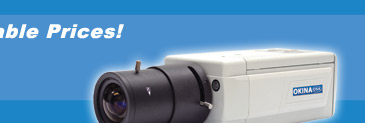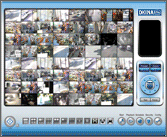Security System Phrase |
|
|
|
|
|
|
|
|
|
|
About Lens |
|
|
|
|
|
|
|
|
|
Understand Lens Concept |
|
|
|
|
|
|
|
| |
|
Resolution |
Camera resolution is expressed in TV Lines. It is the output of the camera and is the result of the picture captured by the Image Sensor and the processing of that information by the Camera electronics. |
CCD |
CCD (Charge-coupled-device) A rectangular piece of silicon rather than a piece of film to receive incoming light. This silicon wafer is a solid-state electronic component which has been micro manufactured and segmented into an array of individual light-sensitive cells called photosites. Each photosite is one element of the whole picture that is formed, thus it is called a picture element, or pixel. 1/3" CCD is a little larger in image size then the 1/4" CCD.
TOP |
CCTV |
Closed Circuit Television. This is a term most security industry use, but for regular individuals its known just as security, or surveillance. |
Image Sensor |
The light sensitivity of the chip inside the camera that converts light into electronic signals. The face of the chip is divided into rows and columns of pixels. Each pixel sends a signal representing the color and brightness of the light that strikes it. |
Lux |
Relative amount of light that will produce a viewable image.
TOP |
Controllers |
There are 3 types of controllers. These will help let you see more than one camera. |
Switchers |
A video switcher is one of the controllers. It can take multiple cameras and will show them on the monitor one at a time. But you can¡¦t select any camera you like or those types of options. It¡¦s the least expensive way to go, but less features and ability. |
DVR |
DVR is equipment which digitally records multiple video signals- generated by CCTV devices. Images are recorded into Hard Disk Drive. DVR is based on personal computer architecture. Consequently, advantages of PC based DVR follows. First, capable of performing quick and easy access of video archive, you can search and display your incidents instantly by hours, minutes and even by seconds. Second, networking via internet by using network adapter or modem, DVR allows you to access CCTV images through internet. Enabling remote monitoring from anywhere in the world. Finally, Data Transformation, one of the biggest advantages of PC is transferring and transforming data. Same rule applies to DVR transfer video data by using CD-RW. This enables replay of video data at any location via PC.
TOP |
Multiplexer |
All our multiplexer are in Real Time unlike others that doesn't have real time. It cost a little more than ones without real time, but doesn't make a mistake in buying the wrong one. Having Real Time and date generator and controls such as digital zoom, etc...full function, will be what you need at the end. A multiplexer is the 3rd type of controller. Multiplexer is the best one and cost more than the quad or switcher. The multiplexer gives you more feature / controls. And what great about it is that, unlike the quad where you have to replay all quads, the multiplexer can replay and view one or all quad selection and zoom in just one channel quad at a time. |
|
|
TOP |
| About Lens |
The format size of a lens must be equal to or greater than the format size of the camera it is being used on. If the lens of smaller format size than the camera then the corners of the scene being viewed will be cut-off. You can use 1/2" lens with a 1/3" camera. But you can not use a 1/3" lens with a 1/2" camera. |
TOP |
Lens Mounts |
A CCTV lens will be specified as either C or CS Mount. Both types of lens look very similar and there is nothing that can be physically measured on a lens, e.g. thread diameter or pitch, to determine whether it is C or CS. The difference between the two types is the position of the focused image behind the lens. CS lenses focus 12.5mm behind the lens whereas C lenses focus 17.5mm behind. Most new lenses tend to be CS mount because they are similar and therefore cheaper to manufacture. Ideally the camera mount and the lens mount should be the same but it is possible to use a C Mount lens on a CS Mount Camera by using 5mm spacing with most body cameras.
|
TOP |
Lens Type |
There are two main types of lens used in CCTV, these are fixed focal length type and zoom (varifocal) lens type.
Focal length of a lens defines its effective viewing angels both horizontally and vertically. Hence the focal length of a lens determines the size of a particular image on the monitor screen or the area of the scene being covered by the camera.
1/3" format lenses on a 1/3" format camera, the following lens focal lengths are commonly available. |
| |
The choice of focal length of lens fitted to a camera affects how big a particular object, etc. a person, will appear on the monitor screen or a video recording from the camera. Obviously, the bigger the image appears on the screen, the better the chances of recognizing or identifying a person being viewed or recorded. |
Guide: Smaller the focal length number = wider field of view |
A. Warehouse or Office, recommendation to go 2.8 - 4.3mm lens (gives from wide to distance view) |
B. Entrance or Lobby, recommendation to use 8mm lens |
For best result on view angle use varifocal lenses to get flexibility to adjust to different angle/distance view. |
TOP |
Lens Lighting |
Most CCTV lenses are equipped with an iris that consists of four or six opaque metal vanes which are arranged to give a roughly circular hole or aperture through which light can pass and then fall on the camera sensor surface. The vanes can be driven together to alter the size of the lens aperture to control the amount of light falling on the sensor and hence alter the picture brightness. |
TOP |
Iris Lens |
Manual Iris Lenses - Recommend for area where light changes is not consistent |
The simplest type of iris control is termed 'Manual Iris'. The lens is equipped with a ring on the body that can be turned to alter the aperture directly. In CCTV systems this can only be used generally in fixed lighting conditions or where the camera is readily accessible and it is not inconvenient to have to continually adjust the lens for correct picture brightness. |
TOP |
Auto Iris Lenses - Recommend for area where light changes consistently |
A far more common arrangement is to use auto-iris lenses where the iris vanes are driven by a galvanometer or servo motor which is controlled by an 'iris-amplifier' circuit within the lens, the control input of which is the video signal from the camera itself. Hence an auto-iris lens is used where the lighting level is liable to continuous changes etc. outdoors where lighting can change from full sunlight down to near total darkness. Auto Iris Lens uses CS type video drive. To us Auto Iris Lens, u must first take off the silver type ring that is place on the C/CS camera. For fixed lens, the ring can be left there, because it uses C drive. After putting the Auto Iris lens on, on back of camera adjust DC to Down. Leave all knob option on back of camera as is. |
|
As a scene gets brighter the video level increases. This is sensed by the lens and the iris is driven to give a smaller aperture, letting less light onto the sensor and so causing the video level to be reduced. Damping is applied to prevent the lens from hunting, etc. causing the picture to continually change brightness. |
|
The relationship between actual video level and corresponding aperture size can be adjusted by the installer using two control potentiometers on the lens. These pots are usually marked 'Level' or 'Gain' and 'ALC' or "P-A', abbreviations for average Level Control and Peak-to-Average respectively. |
TOP |
Direct-Drive Lenses (FCS) |
These are a development on auto-iris lenses where the motor or galvanometer coil moving the iris vanes in the lens is driven directly by the camera, 'Direct-Drive'. There is no active electronics in the lens and hence they are simpler, smaller and cheaper than an equivalent auto-iris lens. They must be used with a camera capable of driving 'DD' lenses and this is normally identified by the presence of the characteristic 4-pin square 'Hi-Rose' (Panasonic) plug on the side of the camera. |
|
Direct Drive lenses have no adjustment controls other than focus (and angle of view in the case of Vari-focal lenses) |
| |
Picture brightness is now controlled by a level setting on the camera. DD lenses slightly less flexible and optimization for outdoor use. |
| |
Setting auto-iris lens |
The iris controls of a lens should be adjusted when the lighting levels are at or near the highest that the camera will be subject to. Never adjust an iris setting of an outdoor camera when light levels are low. If you do then it will almost certainly be necessary to re-adjust them in daylight. |
TOP |
Set the P-A pot to fully average. Point the camera at a bright scene or the brightest part of the scene to be viewed and adjust the level pot until the bright part of the picture just over-exposes and then adjust the pot down slightly until the bright areas are not overexposed. If it is required to make the lens stop down when a highlight enters the picture etc. a door opening, then adjust the P-A pot towards peak. If the average control is adjusted then the level control selling should again be checked and adjusted if necessary. |
TOP |
Vari-focal Lens |
Often it is not possible to determine the focal length of a lens required to meet a particular application or perhaps the angle of view required is not provided by one of the standard lenses available. Narrow range, manually zoomed lenses have been developed to meet these application needs. These are known as range, manually zoomed lenses have bee developed to meet these application needs. These are known as 'Van-focal' lenses. (Variable focal length) and are available in a number of different configurations. The exact angle of view can be set on installation but is important to ensure that the angle required is within the range available from the lens. |
TOP |
Pin-Hole Lens |
These are primarily used for covert surveillance. They have very small front 'objective' lenses which mean that they can be put behind ever small holes and are virtually undetectable. Straight and right-angled models are available to facilitate the mounting of the camera and to reduce the depth required behind the concealing surface. Due to the small objective lens, pin-hole lenses cannot gather as much light as conventional lenses and so their use dictates that the scene illumination is better than would otherwise be required.
|
| |
Typically the maximum apertures available on pin hole lenses is F2.5 to F3.5 which is approximately 2 to 3 stops less than standard lenses. Between 4 and 8 times the normally quoted minimum scene illumination is required for the camera to product a useable picture. |
TOP |
Zoom Lens |
For CCTV applications these are almost exclusively motorized types to enable zooming and focusing of the lens from remote control positions. Zoom ratios etc. the ratio of maximum to minimum focal lengths are most commonly either 6:1 or 10:1. |
TOP |
| Understand Lens Concept |
BLC - (Back Light Compensation) The cameras are fitted with a backlight compensator, this is used to compensate for very bright areas in the picture. In order to counter this problem switch the BLC switch to ON and the camera will try and adjust to compensate for this problem. |
| |
AGC - (Auto Gain Control) Can be switched off by selecting off on the AGC switch. This controls an amplifier that is used to boost the video signal; this may also amplify any noise and may result in a poor picture quality. |
|
AES - (Automatic Electronic Shutter) is used when a manual or fixed iris lens is fitted this will allow the camera to adjust to varying light levels. The AES should be switched off when an Auto Iris Lens is fitted. |
|
Video Drive Lens - If a Video Drive Lens is fitted connect the Iris lead to the four-pin connector on the camera and set the auto iris selection switch to DC Drive the level may be adjusted by turning the level adjust. |
|
Level Adjust - The level adjust is used when a direct drive lens is fitted, the level adjust is used to set the size of the aperture for normal conditions. Turn the level adjust so that the picture appears very dark then turn the level adjust the opposite way until the picture is just to bright, then turn the level adjust back until the desired picture brightness is achieved.
TOP |



